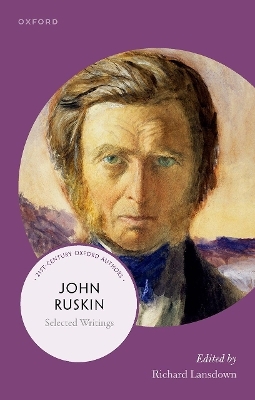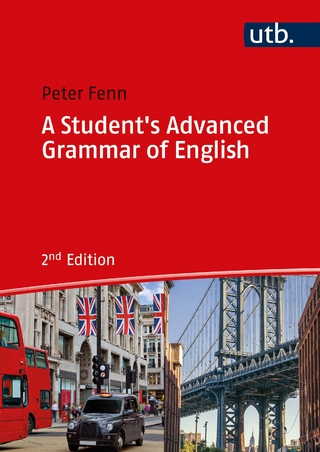
John Ruskin
Oxford University Press (Verlag)
978-0-19-286802-2 (ISBN)
Ruskin has been called 'the most powerful and original thinker of the nineteenth century' and yet, like his two fellow Victorian Sages, Thomas Carlyle and Matthew Arnold, his work remains obscure to modern readers. This anthology hopes to remedy this situation by presenting the immense range of Ruskin's interests, from art to politics, museology to ornithology, architecture to geology, and morals to economics—all of which interests were indivisible in his view. Here are rapturous accounts of Turner, the Alps, Renaissance painters, and Gothic architecture; but here, too, are urgently dystopian analyses of the modern culture that we continue to inhabit: vacuousness in communication, callousness in labour relations, amoral sophistication in art, and rationalism in all its various delusory forms in politics, society, and the economy. There are special stresses on cultural preservation and the illusions that it both fosters and depends upon; the status of women in society, which Ruskin reflected on constantly; nature, wilderness, and eco-catastrophism; and the role of artists like the Pre-Raphaelites in a society mostly given over to Philistinism. In short, the nineteenth century continues to cast an interrogatory shadow over the twenty-first, and Ruskin is its most vital and critical antagonist in the English language, inspiring intellectuals as diverse as Tolstoy, Proust, and Gandhi during his lifetime and afterwards. He was, this collection suggests, nothing like a 'sage', but something much more important and much more like those impossible things, a Victorian Renaissance man, an English Rousseau, and a post-religious Jeremiah.
Explanatory notes and commentary are included, to enhance the study, understanding, and enjoyment of these works, and the edition includes an Introduction to the life and works of Ruskin, and a Chronology.
Richard Lansdown is a graduate of University College London. He is the author of three books on Lord Byron, one with Cambridge, the other two with Oxford University Press, and numerous articles on nineteenth-century literature, from Austen to Ibsen and Hardy to Berlioz and Delacroix. A New Scene of Thought: Studies in Romantic Realism was published in 2016, and Literature and Truth: Imaginative Literature as a Medium for Ideas in 2018, following on from The Autonomy of Literature in 2001. He taught in Finland and Australia before moving to The Netherlands in 2017.
Introduction
Chronology
Further Reading
The Text and the Selection
Ruskin's Artists and Architects: A Catalogue
I. The Aesthete
from The Poetry of Architecture; or The Architecture of the Nations of Europe Considered in Its Association with Natural Scenery and National Character: Chapter 6, 'The Cottage-Concluding Remarks' (1837)
'Remarks on the Present State of Meteorological of Science' (1839)
from Modern Painters, Volume I, Part II, Of Truth: Section ii., 'Of General Truths', Chapter 2, 'Of Truth of Colour'; Section iv., 'Of Truth of Earth', Chapter 4, 'Of the Foreground' (1843)
from Modern Painters, Volume II, Part III, Of Ideas of Beauty: Section i., 'Of the Theoretic Faculty', Chapter 1, 'Of the Rank and Relations of the Theoretic Faculty'; Chapter 2, 'Of the Theoretic Faculty as Concerned with Pleasures of Sense' (1846)
from The Stones of Venice, Volume I, The Foundations: Chapter 1, 'The Quarry', Chapter 30, 'The Vestibule' (1851)
The Pre-Raphaelite Artists: To the Editor of the Times, 13 May 1851
from The Stones of Venice, Volume II, The Sea-Stories: Chapter 4, 'St Mark's', Chapter 6, 'The Nature of Gothic' (1853)
from The Stones of Venice, Volume III, The Fall: Chapter 1, 'Early Renaissance', Chapter 2, 'Roman Renaissance', Chapter 4, 'Conclusion' (1853)
The Light of the World: To the Editor of the Times, 5 May 1854
from Lectures on Architecture and Painting, Delivered at Edinburgh in November 1853: Lecture 1, 'Architecture' (1854)
The Opening of the Crystal Palace, Considered in Some of its Relations to the Prospects of Art (1854)
from Modern Painters, Volume III, Part IV, Of Many Things: Chapter 4, 'Of the False Ideal:-First, Religious'; Chapter 12, 'Of the Pathetic Fallacy' (1856)
from Modern Painters, Volume IV, Part V, Of Mountain Beauty: Chapter 1, 'Of the Turnerian Picturesque'; Chapter 19, 'The Mountain Gloom' (1856)
from The Harbours of England: Chapter 1 (1856)
from Notes on the Royal Academy: 'The Scapegoat' (1856)
from Notes on the Royal Academy: 'A Dream of the Past' (1857)
from The Elements of Drawing: Letter 3, 'On Colour and Composition' (1857)
from Notes on the Turner Gallery at Marlborough House: 'Appendix' (1857)
from Notes on the Royal Academy: 'Water-Colour Societies' (1859)
from The Two Paths: Lectures on Art and its Application to Decoration and Manufacture: Lecture 3, 'Modern Manufacture and Design'; Lecture 5, 'The Work of Iron' (1859)
from Modern Painters, Volume V, Part IX, Of Ideas of Relation: Section ii., 'Of Invention Spiritual': Chapter 2, 'The Lance of Pallas'; Chapter 9, 'The Two Boyhoods'; Chapter 11, 'The Hesperid Æglé'; Chapter 12, 'Peace' (1860)
II. The Prophet
from Essays on Political Economy: Part 3, 'Labour and Trade: The Disease of Desire' (1862)
from The Cestus of Aglaia: Chapter 4, 'Haste' (1865)
from Sesame and Lilies: Two Lectures Delivered at Manchester in 1864: Lecture 1, 'Of Kings' Treasuries'; Lecture 2, 'Of Queens' Gardens' (1865)
from The Ethics of the Dust: Ten Lectures to Little Housewives on the Elements of Crystallisation: Lecture 6, 'Crystal Quarrels' (1865)
from The Crown of Wild Olive: Three Lectures on Work, Traffic, and War: Lecture 2, 'Traffic' (1866)
from Time and Tide by Weare and Tyne: Twenty-Five Letters to a Working Man of Sunderland on the Laws of Work: Letter 7, 'Of the Various Expressions of National Festivity'; Letter 8, 'The Four Possible Theories Respecting the Authority of the Bible'; Letter 9, 'The Use of Music and Dancing under the Jewish Theocracy, Compared with their Use by the Modern French'; Letter 10, 'The Meaning and Actual Operation of Demoniacal Influence'; Letter 11, 'The Satanic Power is Mainly Twofold: the
Power of Causing Falsehood and the Power of Causing Pain. The Resistance is by Law of Honour and Law of Delight' (1867)
The Flamboyant Architecture of the Valley of the Somme (1869)
from The Queen of the Air, Being a Study of the Greek Myths of Cloud and Storm: Lecture 2, 'Athena Keramatis' (1869)
III. The Activist
from Fors Clavigera: Letters to the Workmen and Labourers of Great Britain: Letter 5, 'The White-Thorn Blossom' (1871)
from Fors Clavigera: Letter 11, 'The Abbot's Chapel' (1871)
from Fors Clavigera: Letter 20, 'Benediction' (1872)
from Love's Meinie: Lectures on Greek and English Birds: Lecture 2, 'The Swallow'; Lecture 3, 'The Chough' (1873)
from Val D'Arno: Ten Lectures on the Tuscan Art Directly Antecedent to the Florentine Year of Victories: Lecture 2, 'John the Pisan' (1873)
from Fors Clavigera: Letter 37, 'The City Which Is Our Own' (1874)
from Fors Clavigera: Letter 41, 'Bernard the Happy' (1874)
from Fors Clavigera: Letter 69, 'The Message of Jael-Atropos' (1876)
'The Extension of Railways in the Lake District: A Protest' (1876)
from St Mark's Rest: The History of Venice for the Help of those Few Travellers Who Still Care for Her Monuments: First Supplement, 'The Shrine of the Slaves' (1877)
from 'General Statement Explaining the Nature and Purposes of St George's Guild' (1882)
from Our Fathers Have Told Us: Sketches of the History of Christendom for Boys and Girls Who Have Been Held at its Fonts: Part I, The Bible of Amiens: Chapter 3, 'The Lion Tamer' (1882)
from The Storm-Cloud of the Nineteenth Century: Lecture 2 (1884)
from The Pleasures of England: Lectures Given in Oxford: Lecture 5, 'Protestantism: The Pleasures of Truth' (1884)
from Praeterita: Outlines of Scenes and Thoughts Perhaps Worthy of Memory in my Past Life, Volume I: Chapter 7, 'Papa and Mamma' (1885)
from 'The Guild of St George: Master's Report' (1886)
from Praeterita, Volume II: Chapter 5, 'The Simplon'; Chapter 6, 'The Campo Santo' (1887)
| Erscheinungsdatum | 30.08.2022 |
|---|---|
| Reihe/Serie | 21st-Century Oxford Authors |
| Zusatzinfo | 12 black and white illustrations |
| Verlagsort | Oxford |
| Sprache | englisch |
| Maße | 139 x 216 mm |
| Gewicht | 644 g |
| Themenwelt | Kunst / Musik / Theater ► Allgemeines / Lexika |
| Kunst / Musik / Theater ► Kunstgeschichte / Kunststile | |
| Geisteswissenschaften ► Sprach- / Literaturwissenschaft ► Anglistik / Amerikanistik | |
| Geisteswissenschaften ► Sprach- / Literaturwissenschaft ► Literaturgeschichte | |
| ISBN-10 | 0-19-286802-0 / 0192868020 |
| ISBN-13 | 978-0-19-286802-2 / 9780192868022 |
| Zustand | Neuware |
| Informationen gemäß Produktsicherheitsverordnung (GPSR) | |
| Haben Sie eine Frage zum Produkt? |
aus dem Bereich


